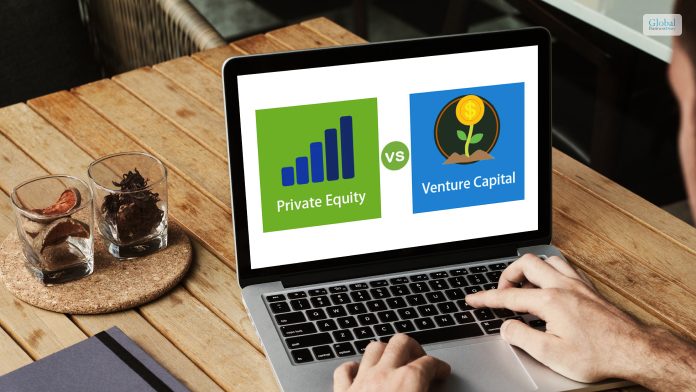Private Equity Vs. Venture Capital: Key Differences

Private equity vs Venture capital – In most cases, people get confused about these two terms and want to know the differences between them. In some cases, they are even used interchangeably. But you must understand beforehand that these two terms do not refer to the same thing. However, in both cases, the terms refer to firms that invest in private companies and keep equity in exchange.
In this article, you will learn in general about private equity and venture capital. Furthermore, we will also discuss the major differences between the two terms. Finally, we will share with you some of the important details regarding private equity and venture capital. Hence, to learn in detail about both these terms, read on through to the end of the article.
Private Equity Vs. Venture Capital – Definitions

According to Investopedia,
“Private equity is sometimes confused with venture capital because both refer to firms that invest in companies and exit by selling their investments in equity financing, for example, by holding initial public offerings (IPOs). However, there are significant differences in the way firms involved in the two types of funding conduct business.”
Both private equity and venture capital make investments in companies of different types and varied sizes. As they do so, they commit different sums of money and claim different equity percentages in the companies in which they are making investments.
Before we learn the differences between private equity and venture capital, it is essential to understand the definitions of the two terms.
Read More: Business Venture Definition, Types, And How To Start?
Private Equity
Private equity refers to a group of investors that make direct investments in a company. These types of investors mainly focus on investing in established companies (and generally shy away from startups). This is done in order to minimize the risk profile of investments and instead allow focus on long-term objectives and growth. With some groups like the Acacia group, there are certain kinds of businesses that are targeted with investment due to knowledge held by any given Acacia equity investment specialist who is looking for new investment opportunities. Having this specialization allows private equity firms to narrow their focus and provide better value to a business in order to help it grow (and generate higher returns on investment).
Other kinds of private equity firms might buy a business in a downturn, improve its operations in the marketplace, and then sell the business to make a profit. The major goal of the private equity investor is to increase the worth of a particular company so that the company generates a better return on investment than the private equity made.
Venture Capital
Venture capitalists are behind the running and functioning of a venture capital firm. Venture capital is also a form of private equity, but there is a difference. A typical private equity firm prefers to invest in stable companies, while venture capital invests in risky startups that have immense growth potential.
Basically, all venture capital firms are private equity firms, while all private equity firms are not venture capital. Venture capitalists provide venture capital to mostly small companies. To ensure that there is a good return on investment, venture capitalists unusually get involved in the decision-making of the business.
Private Equity Vs. Venture Capital – Major Differences

According to Wall Street Mojo,
“Both private equity and venture capital make their investments in the companies. However, in the case of private equity, investment is generally made in the companies in their mature stage of working. In contrast, in the case of venture capital, investment is made in the companies in their early stage of working.”
Before you understand the major differences between private equity and venture capital, it is important for you to understand that both these types of companies make money after exiting. That is, both of them make profits after selling their investments. However, both of them follow different methods of doing so.
The first difference is that private equity firms invest in and buy public companies that are in their mature stage, while venture capital invests in early-stage companies and startups.
While private equity firms invest across all industries, venture capital mainly focuses on technology, cleantech, and biotech, that is the ones that have future returns.
In most cases, private equity firms buy 100% of a company in LBO, while venture capital buys only a minority part of a company. However, it can be up to fifty percent.
Since private equity firms buy mature companies, their investments are large, ranging from $100 million to $10 billion. On the other hand, since venture capital firms deal with smaller companies, their investments are mostly up to $10 million.
To generate capital for investments, private equity firms combine equity and debt, while venture capital firms only make use of equity to make an investment.
Few Things To Consider For Private Equity And Venture Capital

According to USChamber.com,
“One of the advantages of bringing on a private equity investor is that you’ll have access to more than just cash— you’ll also get that person’s expertise. If they have experience within your industry, a private equity investor may help you find opportunities for improvement.”
However, private equity firms get to say how a business is run, as they take a majority stake in the company they are investing in. In some cases, they even have the power to make calls for changing executives. If they think it is the right move, only then do they consider selling the company to make profits with equity.
When a venture capital firm funds a company, it is really very helpful for the latter since they are not mature enough to make great returns. Furthermore, venture capital firms also share their knowledge and expertise in the decision-making process, which helps minimize unnecessary risks and mistakes startups make initially. Venture capital firms also come with various experienced connections, which help the new companies a lot.
Read More: Difference Between Entrepreneur And Entrepreneurship With Examples
Final Thoughts
Hope you have found enough information regarding private equity vs venture capital. You can understand from this article that private equity is what an investment firm invests in a company or other entity that is not publicly listed or traded. Venture capital is a firm that funds startups and other young businesses that have good growth potential.
Both private equity and venture capital buy companies of different types and sizes, claim different equity amounts, and invest different amounts of money. Do you have any further information to add regarding the differences between these two terms? Share your views with us in the comments section below.
Read Also:













